Impact of Change Management Strategies: Air New Zealand Report
VerifiedAdded on 2022/05/26
|9
|2562
|20
Report
AI Summary
This report provides an in-depth analysis of change management strategies implemented by Air New Zealand. The study explores the triggers for change, such as the need for technological upgrades and the optimization of internal processes, particularly in response to the growing size and complexity of the airline's operations. The report examines the impact of these changes, including the creation of the Chief Digital Officer role and the restructuring of digital teams. It applies Lewin's Force Field model to identify change drivers (customer satisfaction, technology optimization) and resistance factors (employee satisfaction, time constraints). Furthermore, the report discusses strategies to mitigate negative impacts, focusing on effective planning, communication, and employee management to overcome resistance and ensure the successful implementation of change initiatives within the organization. Secondary data collection methods were used for research and findings suggest the company has the potential to manage change effectively.
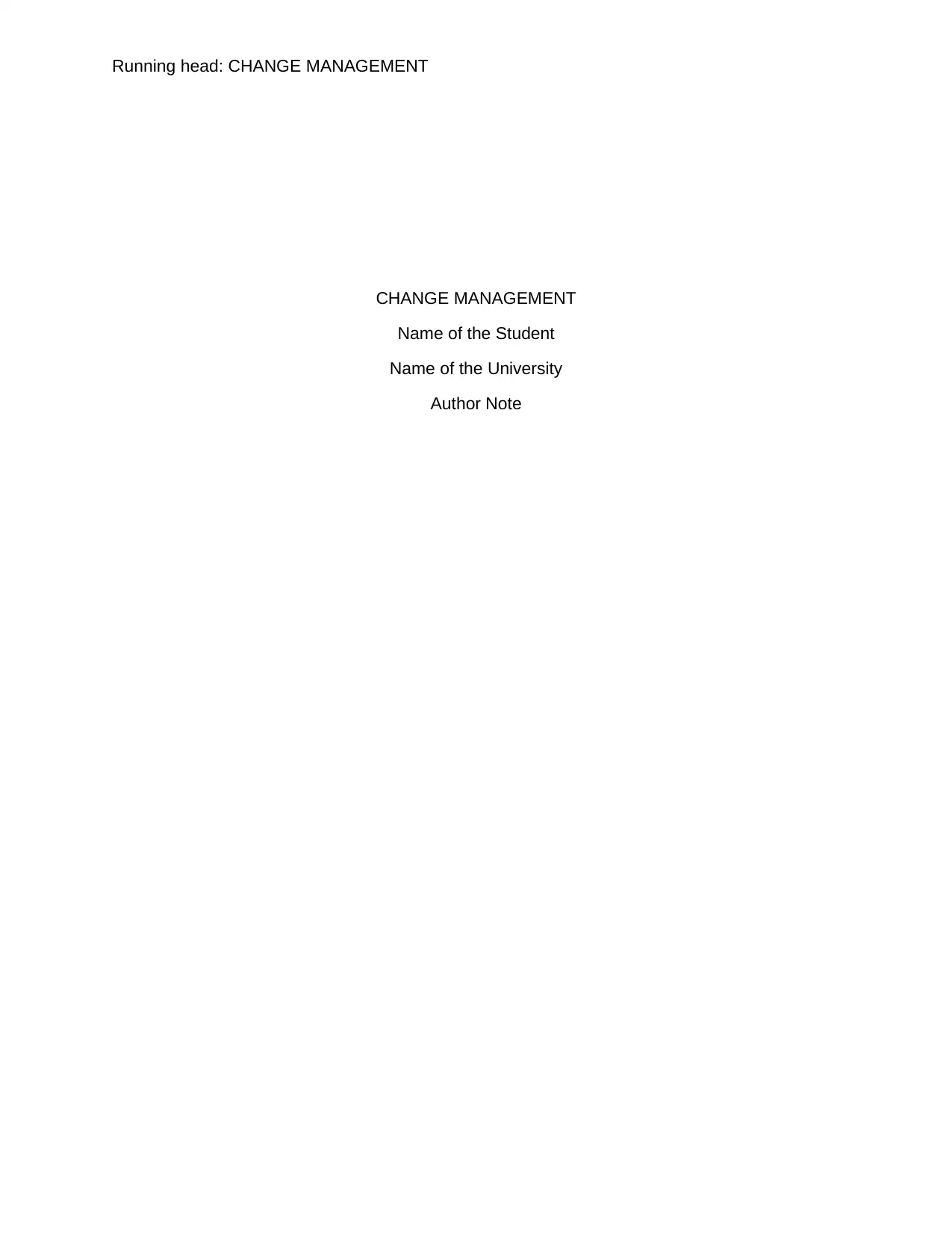
Running head: CHANGE MANAGEMENT
CHANGE MANAGEMENT
Name of the Student
Name of the University
Author Note
CHANGE MANAGEMENT
Name of the Student
Name of the University
Author Note
Paraphrase This Document
Need a fresh take? Get an instant paraphrase of this document with our AI Paraphraser
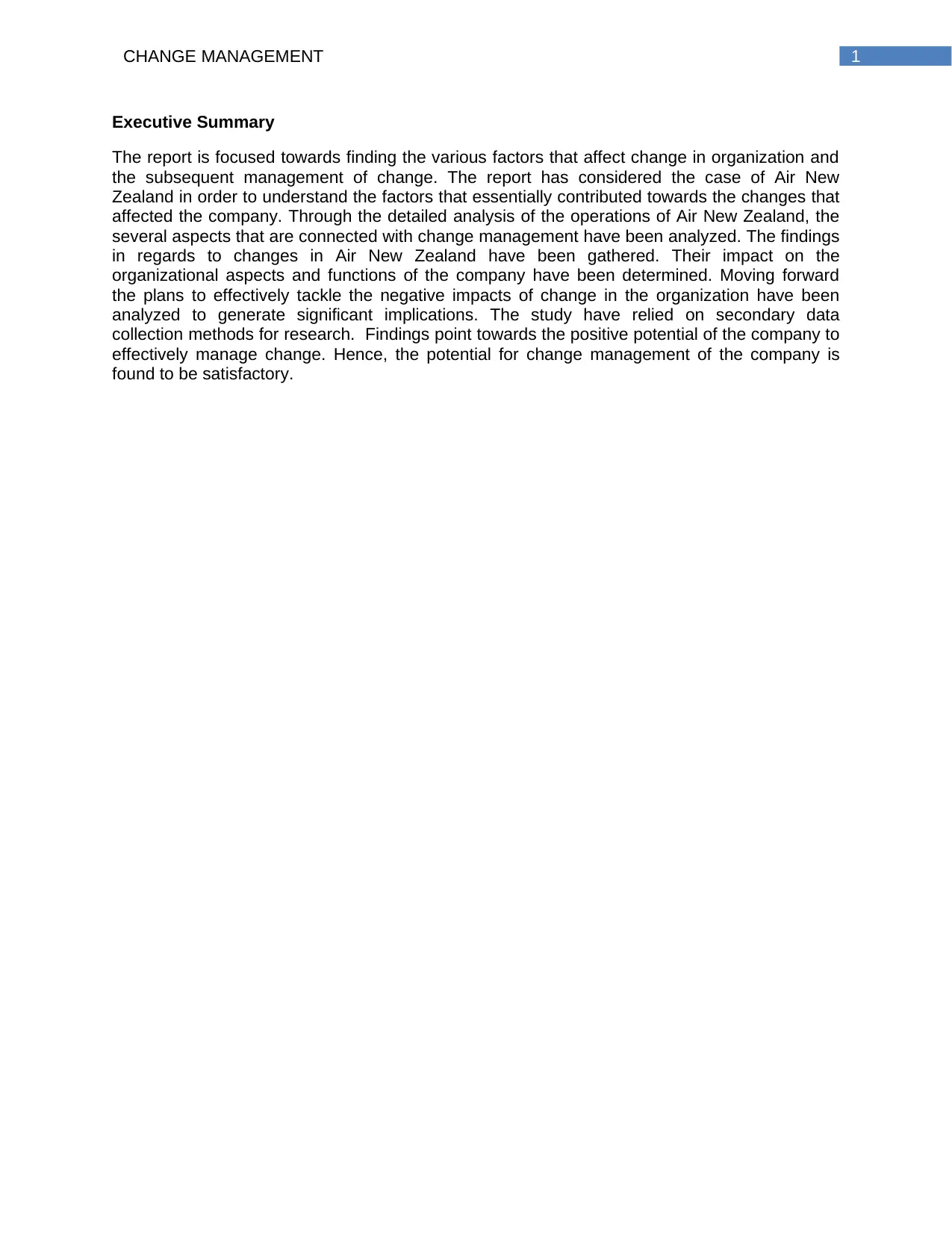
1CHANGE MANAGEMENT
Executive Summary
The report is focused towards finding the various factors that affect change in organization and
the subsequent management of change. The report has considered the case of Air New
Zealand in order to understand the factors that essentially contributed towards the changes that
affected the company. Through the detailed analysis of the operations of Air New Zealand, the
several aspects that are connected with change management have been analyzed. The findings
in regards to changes in Air New Zealand have been gathered. Their impact on the
organizational aspects and functions of the company have been determined. Moving forward
the plans to effectively tackle the negative impacts of change in the organization have been
analyzed to generate significant implications. The study have relied on secondary data
collection methods for research. Findings point towards the positive potential of the company to
effectively manage change. Hence, the potential for change management of the company is
found to be satisfactory.
Executive Summary
The report is focused towards finding the various factors that affect change in organization and
the subsequent management of change. The report has considered the case of Air New
Zealand in order to understand the factors that essentially contributed towards the changes that
affected the company. Through the detailed analysis of the operations of Air New Zealand, the
several aspects that are connected with change management have been analyzed. The findings
in regards to changes in Air New Zealand have been gathered. Their impact on the
organizational aspects and functions of the company have been determined. Moving forward
the plans to effectively tackle the negative impacts of change in the organization have been
analyzed to generate significant implications. The study have relied on secondary data
collection methods for research. Findings point towards the positive potential of the company to
effectively manage change. Hence, the potential for change management of the company is
found to be satisfactory.

2CHANGE MANAGEMENT
Table of Contents
1. Introduction.............................................................................................................................. 3
1.1 Background........................................................................................................................ 3
2. Findings and Analysis.............................................................................................................. 4
2.1 The nature of Change........................................................................................................4
2.2 The Triggers of change......................................................................................................4
2.3 Brief justification of the decisions.......................................................................................4
3. Impact of change.....................................................................................................................5
3.1 Two change drivers considering Lewin’s Force Field model...............................................5
3.2 Two resistance factors considering Lewin’s Force Field model..........................................5
3.3 Potential causes of resistance............................................................................................5
4. Reduction of negative impacts.................................................................................................6
Conclusion................................................................................................................................... 7
References.................................................................................................................................. 8
Table of Contents
1. Introduction.............................................................................................................................. 3
1.1 Background........................................................................................................................ 3
2. Findings and Analysis.............................................................................................................. 4
2.1 The nature of Change........................................................................................................4
2.2 The Triggers of change......................................................................................................4
2.3 Brief justification of the decisions.......................................................................................4
3. Impact of change.....................................................................................................................5
3.1 Two change drivers considering Lewin’s Force Field model...............................................5
3.2 Two resistance factors considering Lewin’s Force Field model..........................................5
3.3 Potential causes of resistance............................................................................................5
4. Reduction of negative impacts.................................................................................................6
Conclusion................................................................................................................................... 7
References.................................................................................................................................. 8
⊘ This is a preview!⊘
Do you want full access?
Subscribe today to unlock all pages.

Trusted by 1+ million students worldwide
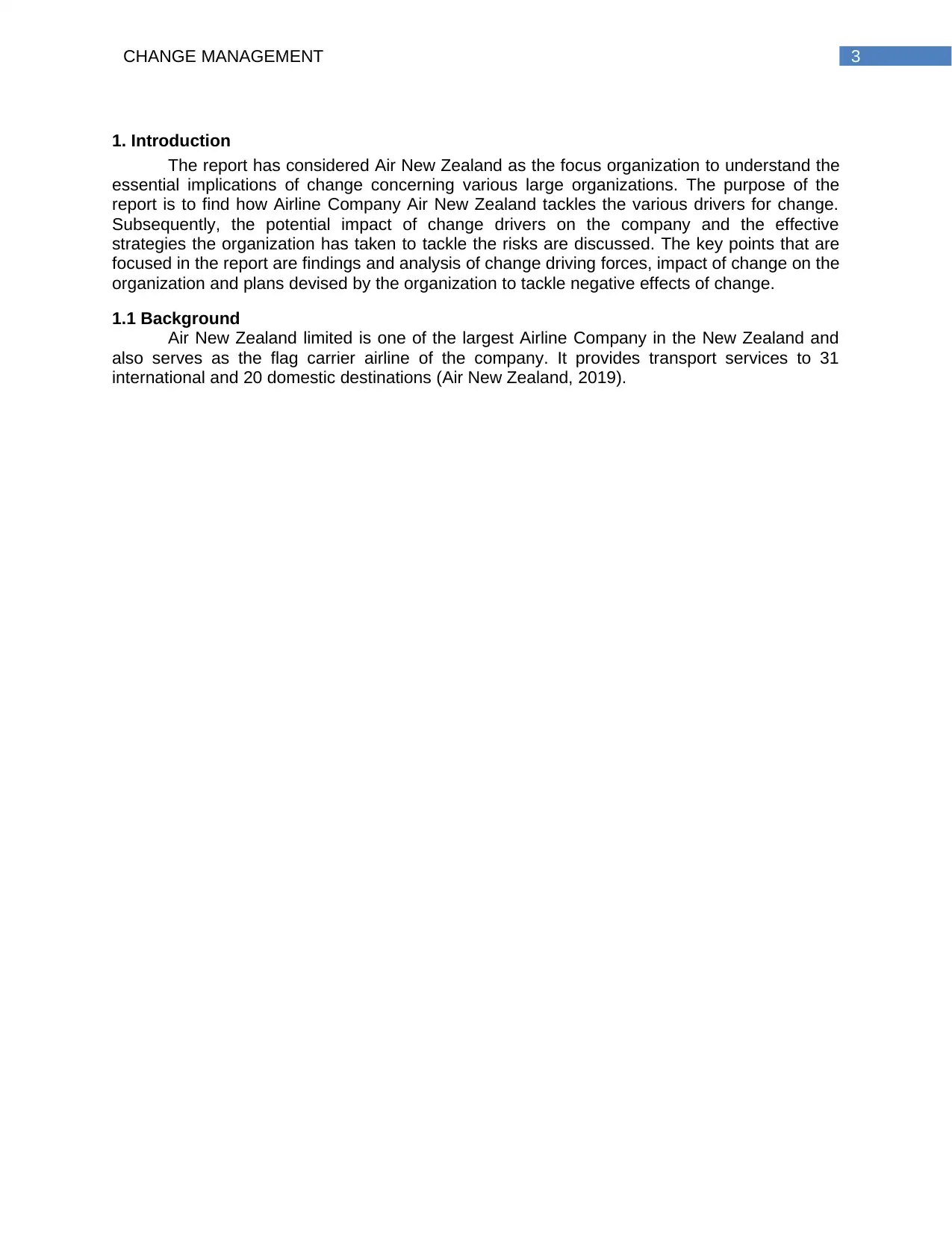
3CHANGE MANAGEMENT
1. Introduction
The report has considered Air New Zealand as the focus organization to understand the
essential implications of change concerning various large organizations. The purpose of the
report is to find how Airline Company Air New Zealand tackles the various drivers for change.
Subsequently, the potential impact of change drivers on the company and the effective
strategies the organization has taken to tackle the risks are discussed. The key points that are
focused in the report are findings and analysis of change driving forces, impact of change on the
organization and plans devised by the organization to tackle negative effects of change.
1.1 Background
Air New Zealand limited is one of the largest Airline Company in the New Zealand and
also serves as the flag carrier airline of the company. It provides transport services to 31
international and 20 domestic destinations (Air New Zealand, 2019).
1. Introduction
The report has considered Air New Zealand as the focus organization to understand the
essential implications of change concerning various large organizations. The purpose of the
report is to find how Airline Company Air New Zealand tackles the various drivers for change.
Subsequently, the potential impact of change drivers on the company and the effective
strategies the organization has taken to tackle the risks are discussed. The key points that are
focused in the report are findings and analysis of change driving forces, impact of change on the
organization and plans devised by the organization to tackle negative effects of change.
1.1 Background
Air New Zealand limited is one of the largest Airline Company in the New Zealand and
also serves as the flag carrier airline of the company. It provides transport services to 31
international and 20 domestic destinations (Air New Zealand, 2019).
Paraphrase This Document
Need a fresh take? Get an instant paraphrase of this document with our AI Paraphraser
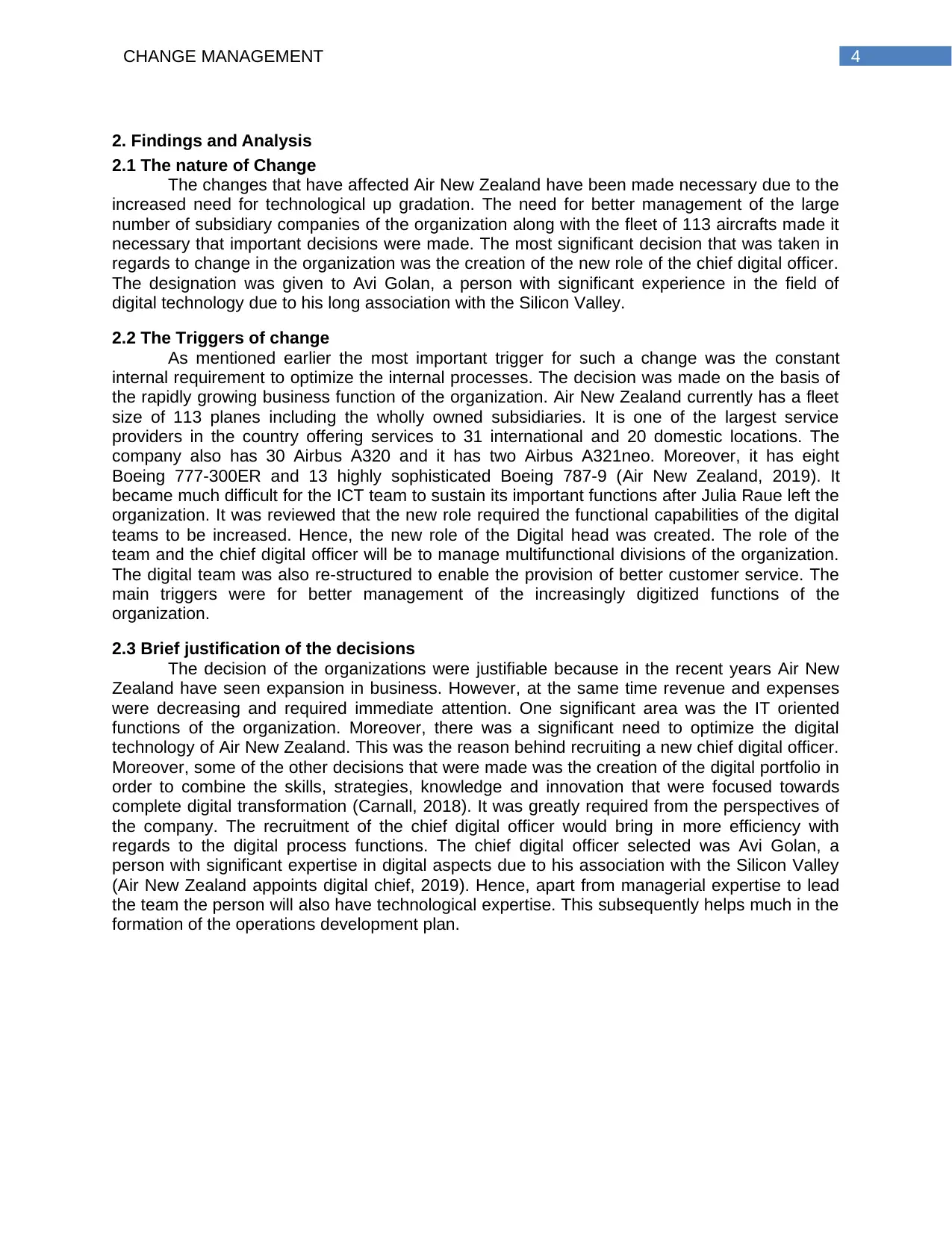
4CHANGE MANAGEMENT
2. Findings and Analysis
2.1 The nature of Change
The changes that have affected Air New Zealand have been made necessary due to the
increased need for technological up gradation. The need for better management of the large
number of subsidiary companies of the organization along with the fleet of 113 aircrafts made it
necessary that important decisions were made. The most significant decision that was taken in
regards to change in the organization was the creation of the new role of the chief digital officer.
The designation was given to Avi Golan, a person with significant experience in the field of
digital technology due to his long association with the Silicon Valley.
2.2 The Triggers of change
As mentioned earlier the most important trigger for such a change was the constant
internal requirement to optimize the internal processes. The decision was made on the basis of
the rapidly growing business function of the organization. Air New Zealand currently has a fleet
size of 113 planes including the wholly owned subsidiaries. It is one of the largest service
providers in the country offering services to 31 international and 20 domestic locations. The
company also has 30 Airbus A320 and it has two Airbus A321neo. Moreover, it has eight
Boeing 777-300ER and 13 highly sophisticated Boeing 787-9 (Air New Zealand, 2019). It
became much difficult for the ICT team to sustain its important functions after Julia Raue left the
organization. It was reviewed that the new role required the functional capabilities of the digital
teams to be increased. Hence, the new role of the Digital head was created. The role of the
team and the chief digital officer will be to manage multifunctional divisions of the organization.
The digital team was also re-structured to enable the provision of better customer service. The
main triggers were for better management of the increasingly digitized functions of the
organization.
2.3 Brief justification of the decisions
The decision of the organizations were justifiable because in the recent years Air New
Zealand have seen expansion in business. However, at the same time revenue and expenses
were decreasing and required immediate attention. One significant area was the IT oriented
functions of the organization. Moreover, there was a significant need to optimize the digital
technology of Air New Zealand. This was the reason behind recruiting a new chief digital officer.
Moreover, some of the other decisions that were made was the creation of the digital portfolio in
order to combine the skills, strategies, knowledge and innovation that were focused towards
complete digital transformation (Carnall, 2018). It was greatly required from the perspectives of
the company. The recruitment of the chief digital officer would bring in more efficiency with
regards to the digital process functions. The chief digital officer selected was Avi Golan, a
person with significant expertise in digital aspects due to his association with the Silicon Valley
(Air New Zealand appoints digital chief, 2019). Hence, apart from managerial expertise to lead
the team the person will also have technological expertise. This subsequently helps much in the
formation of the operations development plan.
2. Findings and Analysis
2.1 The nature of Change
The changes that have affected Air New Zealand have been made necessary due to the
increased need for technological up gradation. The need for better management of the large
number of subsidiary companies of the organization along with the fleet of 113 aircrafts made it
necessary that important decisions were made. The most significant decision that was taken in
regards to change in the organization was the creation of the new role of the chief digital officer.
The designation was given to Avi Golan, a person with significant experience in the field of
digital technology due to his long association with the Silicon Valley.
2.2 The Triggers of change
As mentioned earlier the most important trigger for such a change was the constant
internal requirement to optimize the internal processes. The decision was made on the basis of
the rapidly growing business function of the organization. Air New Zealand currently has a fleet
size of 113 planes including the wholly owned subsidiaries. It is one of the largest service
providers in the country offering services to 31 international and 20 domestic locations. The
company also has 30 Airbus A320 and it has two Airbus A321neo. Moreover, it has eight
Boeing 777-300ER and 13 highly sophisticated Boeing 787-9 (Air New Zealand, 2019). It
became much difficult for the ICT team to sustain its important functions after Julia Raue left the
organization. It was reviewed that the new role required the functional capabilities of the digital
teams to be increased. Hence, the new role of the Digital head was created. The role of the
team and the chief digital officer will be to manage multifunctional divisions of the organization.
The digital team was also re-structured to enable the provision of better customer service. The
main triggers were for better management of the increasingly digitized functions of the
organization.
2.3 Brief justification of the decisions
The decision of the organizations were justifiable because in the recent years Air New
Zealand have seen expansion in business. However, at the same time revenue and expenses
were decreasing and required immediate attention. One significant area was the IT oriented
functions of the organization. Moreover, there was a significant need to optimize the digital
technology of Air New Zealand. This was the reason behind recruiting a new chief digital officer.
Moreover, some of the other decisions that were made was the creation of the digital portfolio in
order to combine the skills, strategies, knowledge and innovation that were focused towards
complete digital transformation (Carnall, 2018). It was greatly required from the perspectives of
the company. The recruitment of the chief digital officer would bring in more efficiency with
regards to the digital process functions. The chief digital officer selected was Avi Golan, a
person with significant expertise in digital aspects due to his association with the Silicon Valley
(Air New Zealand appoints digital chief, 2019). Hence, apart from managerial expertise to lead
the team the person will also have technological expertise. This subsequently helps much in the
formation of the operations development plan.
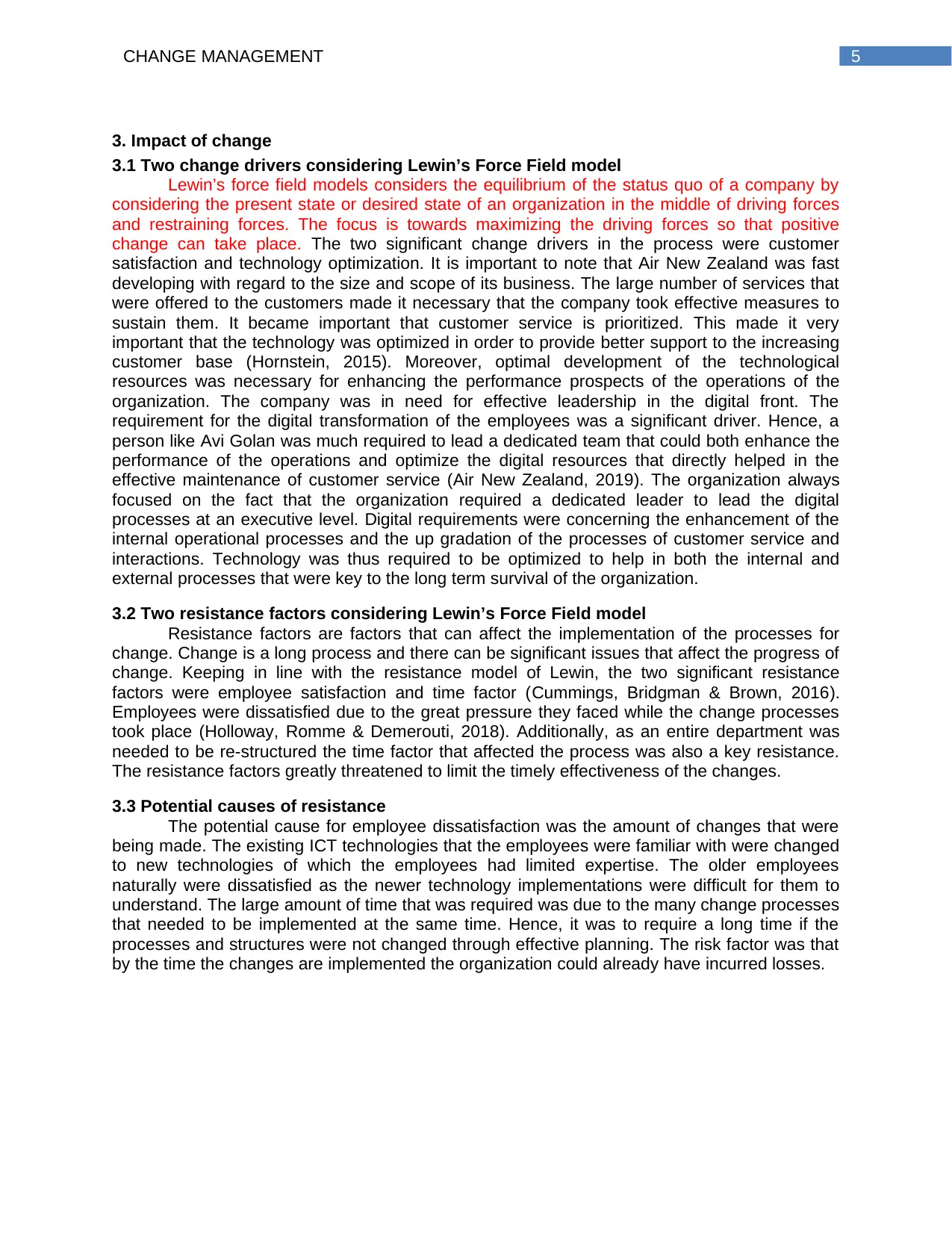
5CHANGE MANAGEMENT
3. Impact of change
3.1 Two change drivers considering Lewin’s Force Field model
Lewin’s force field models considers the equilibrium of the status quo of a company by
considering the present state or desired state of an organization in the middle of driving forces
and restraining forces. The focus is towards maximizing the driving forces so that positive
change can take place. The two significant change drivers in the process were customer
satisfaction and technology optimization. It is important to note that Air New Zealand was fast
developing with regard to the size and scope of its business. The large number of services that
were offered to the customers made it necessary that the company took effective measures to
sustain them. It became important that customer service is prioritized. This made it very
important that the technology was optimized in order to provide better support to the increasing
customer base (Hornstein, 2015). Moreover, optimal development of the technological
resources was necessary for enhancing the performance prospects of the operations of the
organization. The company was in need for effective leadership in the digital front. The
requirement for the digital transformation of the employees was a significant driver. Hence, a
person like Avi Golan was much required to lead a dedicated team that could both enhance the
performance of the operations and optimize the digital resources that directly helped in the
effective maintenance of customer service (Air New Zealand, 2019). The organization always
focused on the fact that the organization required a dedicated leader to lead the digital
processes at an executive level. Digital requirements were concerning the enhancement of the
internal operational processes and the up gradation of the processes of customer service and
interactions. Technology was thus required to be optimized to help in both the internal and
external processes that were key to the long term survival of the organization.
3.2 Two resistance factors considering Lewin’s Force Field model
Resistance factors are factors that can affect the implementation of the processes for
change. Change is a long process and there can be significant issues that affect the progress of
change. Keeping in line with the resistance model of Lewin, the two significant resistance
factors were employee satisfaction and time factor (Cummings, Bridgman & Brown, 2016).
Employees were dissatisfied due to the great pressure they faced while the change processes
took place (Holloway, Romme & Demerouti, 2018). Additionally, as an entire department was
needed to be re-structured the time factor that affected the process was also a key resistance.
The resistance factors greatly threatened to limit the timely effectiveness of the changes.
3.3 Potential causes of resistance
The potential cause for employee dissatisfaction was the amount of changes that were
being made. The existing ICT technologies that the employees were familiar with were changed
to new technologies of which the employees had limited expertise. The older employees
naturally were dissatisfied as the newer technology implementations were difficult for them to
understand. The large amount of time that was required was due to the many change processes
that needed to be implemented at the same time. Hence, it was to require a long time if the
processes and structures were not changed through effective planning. The risk factor was that
by the time the changes are implemented the organization could already have incurred losses.
3. Impact of change
3.1 Two change drivers considering Lewin’s Force Field model
Lewin’s force field models considers the equilibrium of the status quo of a company by
considering the present state or desired state of an organization in the middle of driving forces
and restraining forces. The focus is towards maximizing the driving forces so that positive
change can take place. The two significant change drivers in the process were customer
satisfaction and technology optimization. It is important to note that Air New Zealand was fast
developing with regard to the size and scope of its business. The large number of services that
were offered to the customers made it necessary that the company took effective measures to
sustain them. It became important that customer service is prioritized. This made it very
important that the technology was optimized in order to provide better support to the increasing
customer base (Hornstein, 2015). Moreover, optimal development of the technological
resources was necessary for enhancing the performance prospects of the operations of the
organization. The company was in need for effective leadership in the digital front. The
requirement for the digital transformation of the employees was a significant driver. Hence, a
person like Avi Golan was much required to lead a dedicated team that could both enhance the
performance of the operations and optimize the digital resources that directly helped in the
effective maintenance of customer service (Air New Zealand, 2019). The organization always
focused on the fact that the organization required a dedicated leader to lead the digital
processes at an executive level. Digital requirements were concerning the enhancement of the
internal operational processes and the up gradation of the processes of customer service and
interactions. Technology was thus required to be optimized to help in both the internal and
external processes that were key to the long term survival of the organization.
3.2 Two resistance factors considering Lewin’s Force Field model
Resistance factors are factors that can affect the implementation of the processes for
change. Change is a long process and there can be significant issues that affect the progress of
change. Keeping in line with the resistance model of Lewin, the two significant resistance
factors were employee satisfaction and time factor (Cummings, Bridgman & Brown, 2016).
Employees were dissatisfied due to the great pressure they faced while the change processes
took place (Holloway, Romme & Demerouti, 2018). Additionally, as an entire department was
needed to be re-structured the time factor that affected the process was also a key resistance.
The resistance factors greatly threatened to limit the timely effectiveness of the changes.
3.3 Potential causes of resistance
The potential cause for employee dissatisfaction was the amount of changes that were
being made. The existing ICT technologies that the employees were familiar with were changed
to new technologies of which the employees had limited expertise. The older employees
naturally were dissatisfied as the newer technology implementations were difficult for them to
understand. The large amount of time that was required was due to the many change processes
that needed to be implemented at the same time. Hence, it was to require a long time if the
processes and structures were not changed through effective planning. The risk factor was that
by the time the changes are implemented the organization could already have incurred losses.
⊘ This is a preview!⊘
Do you want full access?
Subscribe today to unlock all pages.

Trusted by 1+ million students worldwide
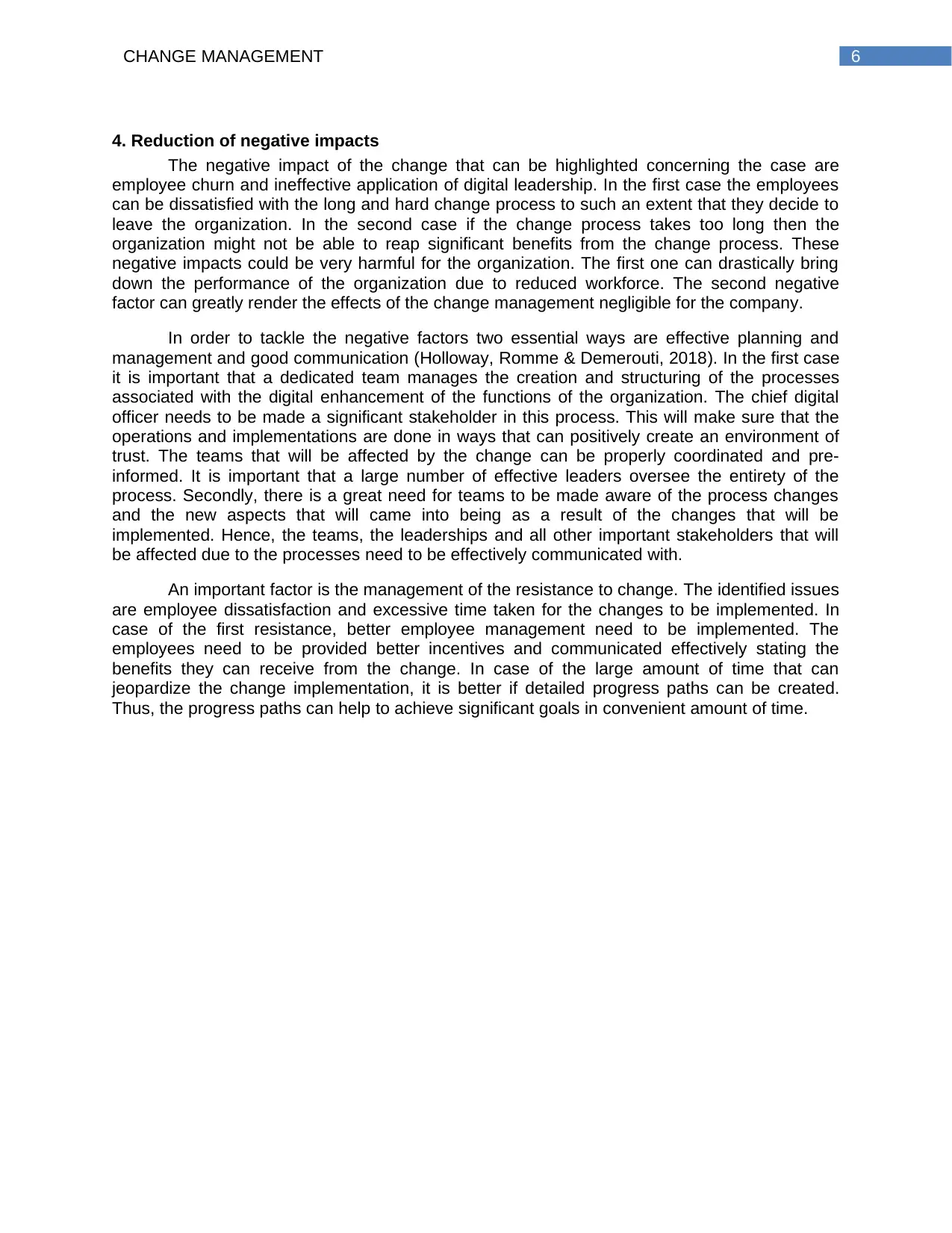
6CHANGE MANAGEMENT
4. Reduction of negative impacts
The negative impact of the change that can be highlighted concerning the case are
employee churn and ineffective application of digital leadership. In the first case the employees
can be dissatisfied with the long and hard change process to such an extent that they decide to
leave the organization. In the second case if the change process takes too long then the
organization might not be able to reap significant benefits from the change process. These
negative impacts could be very harmful for the organization. The first one can drastically bring
down the performance of the organization due to reduced workforce. The second negative
factor can greatly render the effects of the change management negligible for the company.
In order to tackle the negative factors two essential ways are effective planning and
management and good communication (Holloway, Romme & Demerouti, 2018). In the first case
it is important that a dedicated team manages the creation and structuring of the processes
associated with the digital enhancement of the functions of the organization. The chief digital
officer needs to be made a significant stakeholder in this process. This will make sure that the
operations and implementations are done in ways that can positively create an environment of
trust. The teams that will be affected by the change can be properly coordinated and pre-
informed. It is important that a large number of effective leaders oversee the entirety of the
process. Secondly, there is a great need for teams to be made aware of the process changes
and the new aspects that will came into being as a result of the changes that will be
implemented. Hence, the teams, the leaderships and all other important stakeholders that will
be affected due to the processes need to be effectively communicated with.
An important factor is the management of the resistance to change. The identified issues
are employee dissatisfaction and excessive time taken for the changes to be implemented. In
case of the first resistance, better employee management need to be implemented. The
employees need to be provided better incentives and communicated effectively stating the
benefits they can receive from the change. In case of the large amount of time that can
jeopardize the change implementation, it is better if detailed progress paths can be created.
Thus, the progress paths can help to achieve significant goals in convenient amount of time.
4. Reduction of negative impacts
The negative impact of the change that can be highlighted concerning the case are
employee churn and ineffective application of digital leadership. In the first case the employees
can be dissatisfied with the long and hard change process to such an extent that they decide to
leave the organization. In the second case if the change process takes too long then the
organization might not be able to reap significant benefits from the change process. These
negative impacts could be very harmful for the organization. The first one can drastically bring
down the performance of the organization due to reduced workforce. The second negative
factor can greatly render the effects of the change management negligible for the company.
In order to tackle the negative factors two essential ways are effective planning and
management and good communication (Holloway, Romme & Demerouti, 2018). In the first case
it is important that a dedicated team manages the creation and structuring of the processes
associated with the digital enhancement of the functions of the organization. The chief digital
officer needs to be made a significant stakeholder in this process. This will make sure that the
operations and implementations are done in ways that can positively create an environment of
trust. The teams that will be affected by the change can be properly coordinated and pre-
informed. It is important that a large number of effective leaders oversee the entirety of the
process. Secondly, there is a great need for teams to be made aware of the process changes
and the new aspects that will came into being as a result of the changes that will be
implemented. Hence, the teams, the leaderships and all other important stakeholders that will
be affected due to the processes need to be effectively communicated with.
An important factor is the management of the resistance to change. The identified issues
are employee dissatisfaction and excessive time taken for the changes to be implemented. In
case of the first resistance, better employee management need to be implemented. The
employees need to be provided better incentives and communicated effectively stating the
benefits they can receive from the change. In case of the large amount of time that can
jeopardize the change implementation, it is better if detailed progress paths can be created.
Thus, the progress paths can help to achieve significant goals in convenient amount of time.
Paraphrase This Document
Need a fresh take? Get an instant paraphrase of this document with our AI Paraphraser
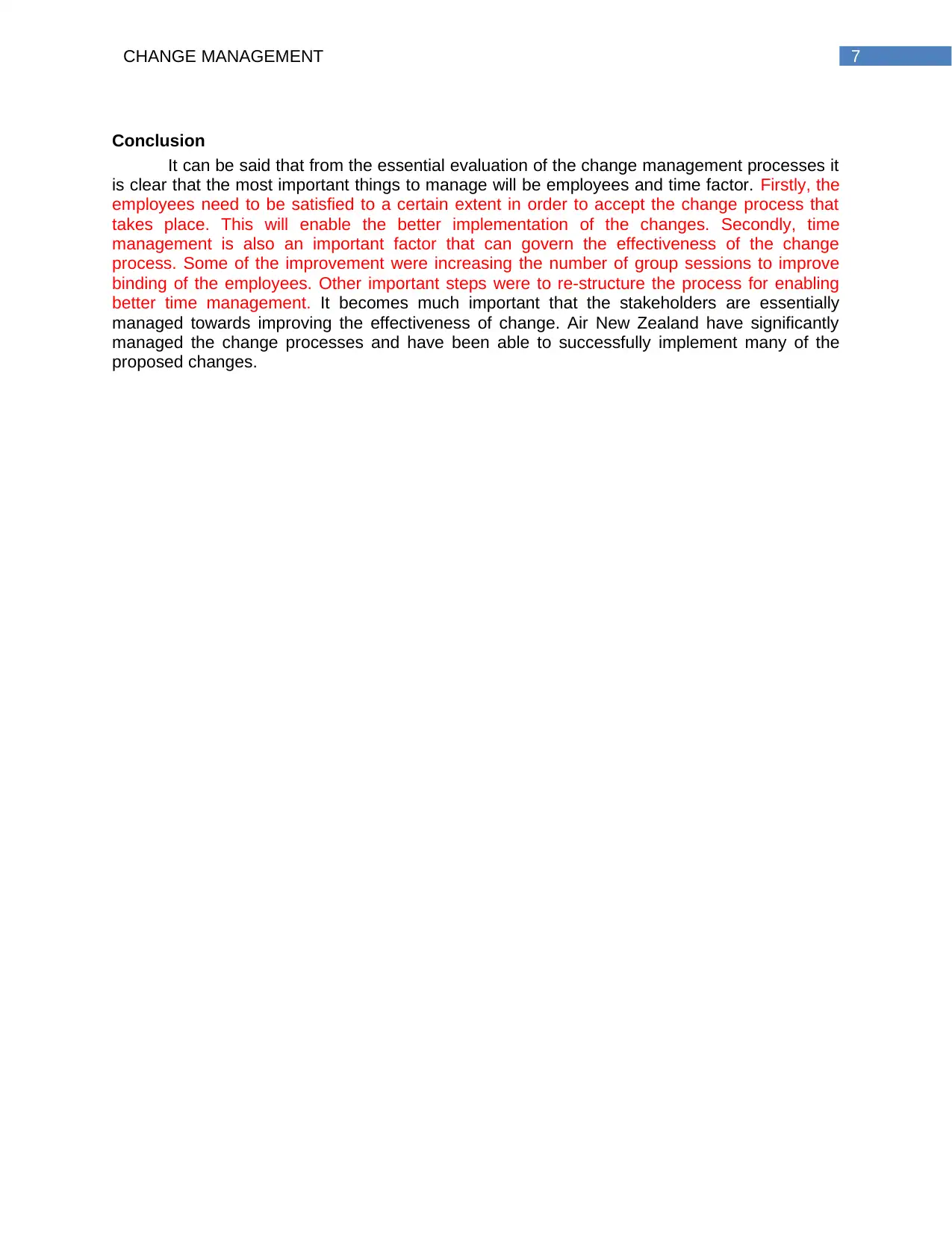
7CHANGE MANAGEMENT
Conclusion
It can be said that from the essential evaluation of the change management processes it
is clear that the most important things to manage will be employees and time factor. Firstly, the
employees need to be satisfied to a certain extent in order to accept the change process that
takes place. This will enable the better implementation of the changes. Secondly, time
management is also an important factor that can govern the effectiveness of the change
process. Some of the improvement were increasing the number of group sessions to improve
binding of the employees. Other important steps were to re-structure the process for enabling
better time management. It becomes much important that the stakeholders are essentially
managed towards improving the effectiveness of change. Air New Zealand have significantly
managed the change processes and have been able to successfully implement many of the
proposed changes.
Conclusion
It can be said that from the essential evaluation of the change management processes it
is clear that the most important things to manage will be employees and time factor. Firstly, the
employees need to be satisfied to a certain extent in order to accept the change process that
takes place. This will enable the better implementation of the changes. Secondly, time
management is also an important factor that can govern the effectiveness of the change
process. Some of the improvement were increasing the number of group sessions to improve
binding of the employees. Other important steps were to re-structure the process for enabling
better time management. It becomes much important that the stakeholders are essentially
managed towards improving the effectiveness of change. Air New Zealand have significantly
managed the change processes and have been able to successfully implement many of the
proposed changes.
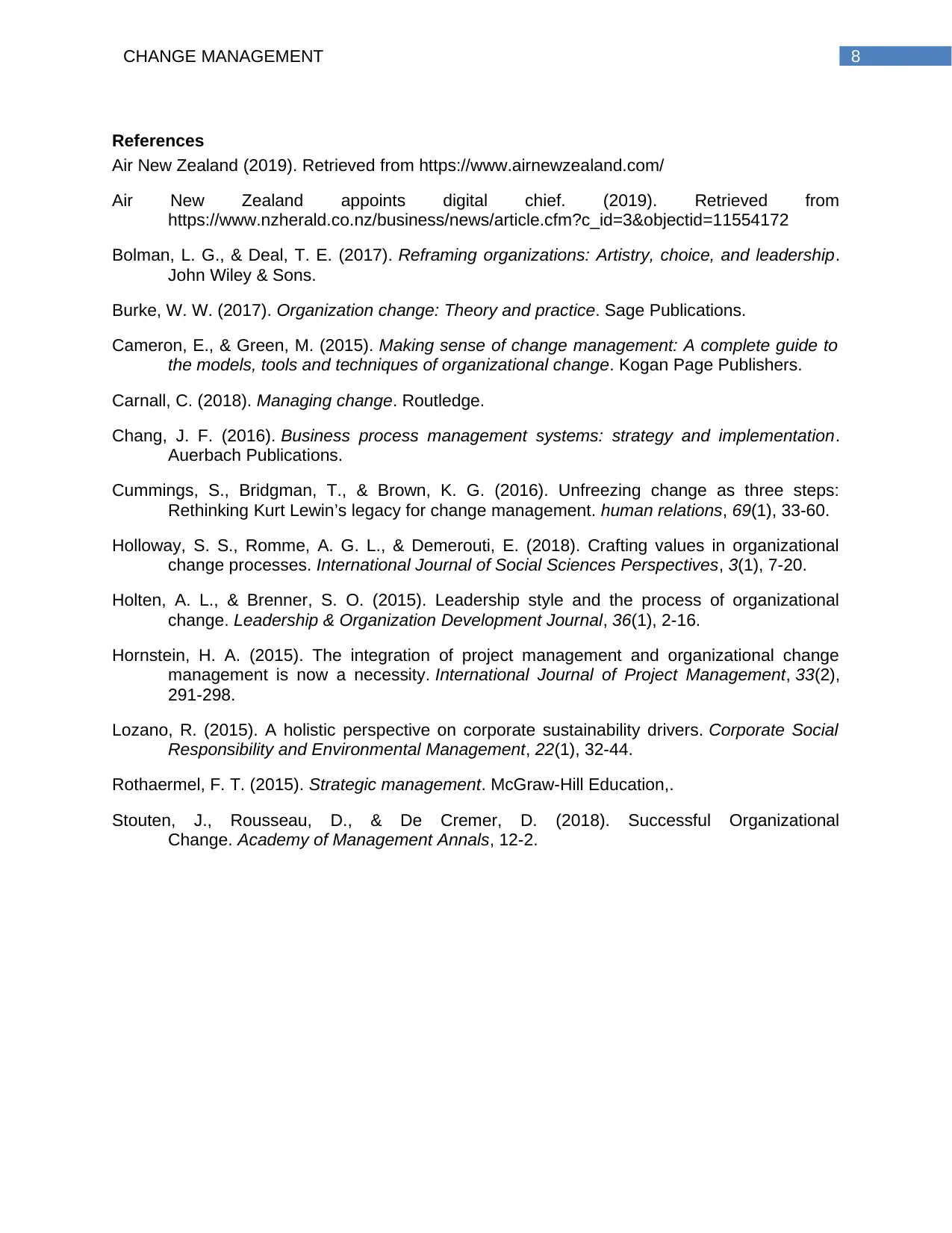
8CHANGE MANAGEMENT
References
Air New Zealand (2019). Retrieved from https://www.airnewzealand.com/
Air New Zealand appoints digital chief. (2019). Retrieved from
https://www.nzherald.co.nz/business/news/article.cfm?c_id=3&objectid=11554172
Bolman, L. G., & Deal, T. E. (2017). Reframing organizations: Artistry, choice, and leadership.
John Wiley & Sons.
Burke, W. W. (2017). Organization change: Theory and practice. Sage Publications.
Cameron, E., & Green, M. (2015). Making sense of change management: A complete guide to
the models, tools and techniques of organizational change. Kogan Page Publishers.
Carnall, C. (2018). Managing change. Routledge.
Chang, J. F. (2016). Business process management systems: strategy and implementation.
Auerbach Publications.
Cummings, S., Bridgman, T., & Brown, K. G. (2016). Unfreezing change as three steps:
Rethinking Kurt Lewin’s legacy for change management. human relations, 69(1), 33-60.
Holloway, S. S., Romme, A. G. L., & Demerouti, E. (2018). Crafting values in organizational
change processes. International Journal of Social Sciences Perspectives, 3(1), 7-20.
Holten, A. L., & Brenner, S. O. (2015). Leadership style and the process of organizational
change. Leadership & Organization Development Journal, 36(1), 2-16.
Hornstein, H. A. (2015). The integration of project management and organizational change
management is now a necessity. International Journal of Project Management, 33(2),
291-298.
Lozano, R. (2015). A holistic perspective on corporate sustainability drivers. Corporate Social
Responsibility and Environmental Management, 22(1), 32-44.
Rothaermel, F. T. (2015). Strategic management. McGraw-Hill Education,.
Stouten, J., Rousseau, D., & De Cremer, D. (2018). Successful Organizational
Change. Academy of Management Annals, 12-2.
References
Air New Zealand (2019). Retrieved from https://www.airnewzealand.com/
Air New Zealand appoints digital chief. (2019). Retrieved from
https://www.nzherald.co.nz/business/news/article.cfm?c_id=3&objectid=11554172
Bolman, L. G., & Deal, T. E. (2017). Reframing organizations: Artistry, choice, and leadership.
John Wiley & Sons.
Burke, W. W. (2017). Organization change: Theory and practice. Sage Publications.
Cameron, E., & Green, M. (2015). Making sense of change management: A complete guide to
the models, tools and techniques of organizational change. Kogan Page Publishers.
Carnall, C. (2018). Managing change. Routledge.
Chang, J. F. (2016). Business process management systems: strategy and implementation.
Auerbach Publications.
Cummings, S., Bridgman, T., & Brown, K. G. (2016). Unfreezing change as three steps:
Rethinking Kurt Lewin’s legacy for change management. human relations, 69(1), 33-60.
Holloway, S. S., Romme, A. G. L., & Demerouti, E. (2018). Crafting values in organizational
change processes. International Journal of Social Sciences Perspectives, 3(1), 7-20.
Holten, A. L., & Brenner, S. O. (2015). Leadership style and the process of organizational
change. Leadership & Organization Development Journal, 36(1), 2-16.
Hornstein, H. A. (2015). The integration of project management and organizational change
management is now a necessity. International Journal of Project Management, 33(2),
291-298.
Lozano, R. (2015). A holistic perspective on corporate sustainability drivers. Corporate Social
Responsibility and Environmental Management, 22(1), 32-44.
Rothaermel, F. T. (2015). Strategic management. McGraw-Hill Education,.
Stouten, J., Rousseau, D., & De Cremer, D. (2018). Successful Organizational
Change. Academy of Management Annals, 12-2.
⊘ This is a preview!⊘
Do you want full access?
Subscribe today to unlock all pages.

Trusted by 1+ million students worldwide
1 out of 9
Related Documents
Your All-in-One AI-Powered Toolkit for Academic Success.
+13062052269
info@desklib.com
Available 24*7 on WhatsApp / Email
![[object Object]](/_next/static/media/star-bottom.7253800d.svg)
Unlock your academic potential
Copyright © 2020–2026 A2Z Services. All Rights Reserved. Developed and managed by ZUCOL.



